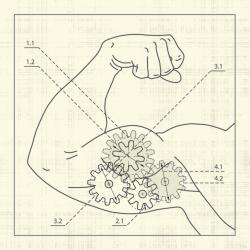Strength training, resistance training, working with free weights or machines and any other form of physical exertion can be dangerous if not approached properly. The 5 Strength Training Safety Tips included here are basics, and you may be taking them for granted currently.
But if your strength training workout is going to deliver the results you desire, you have to be healthy to implement it. That means if you are hurt, you can not work out, so follow these top 5 tips for strength training safety to ensure injury-free exercise.
1) Warm Up Before You Get Started, and Cool Down Afterwards
Okay, this is really two tips in one, and you are probably nodding your head and thinking, “I already knew this.” But a report from the Harvard Medical School shows that more than half of all non-professional strength trainers and weightlifters fail to either warm up before they get started, cool down afterwards, or both. And this can lead to injuries. Walking or climbing stairs for 5 to 10 minutes is enough to get your body ready for your workout, and the same amount of stretching will cool you down properly.
2) Practice Good Form
Don’t think about the weight, think about your form. Always align your body correctly according to the exercise or strength training move you are making. Poor form can not only result in injuries, both immediate and over time, but it can also slow down the delivery of the results you are looking for. Many strength training experts recommend starting with no weight or a very low weight at first until your muscle memory reflex helps you perform each exercise correctly.
3) Stick to an Established Routine
The human brain commits to memory and habit with anything you do 17 to 21 times in a row, in the same way, and at roughly the same time each day or night. Pick your strength training days for each week and stick with them. This “second nature” programming means you are less likely to injure yourself. It also helps your body understand when its muscles will be stressed and when they will repair, leading to more consistent results as you increase the weight, sets and reps in your strength training workout over time.
4) Give Your Muscles Time to Repair
Lots of water and proper nutrition are needed after you workout, and after an intensive strength training session, your muscles also require at least 48 hours to recover properly. When you stress your muscles, you create small tears in your muscle tissue. Not letting them heal before stressing them again can cause significant short and long-term injuries. Also, given proper hydration and nutrition as well as enough downtime, your desired results will start to materialize quicker.
5) Dress Appropriately for Strength Training Safety
Your clothing should allow for a full range of motion, regardless what exercises or routines your strength training regimen requires. Jeans are a no-no in the gym or wherever you workout regularly, because such restrictive clothing can cause a loss of balance and a significant injury, especially if you are dealing with heavy weights.
Safety should be your number one priority in the gym, your garage or wherever you decide to perform your strength training exercises. When handled properly, weightlifting and strength training are some of the safest physical exertion activities you can enjoy.
Whenever in doubt, think before acting or performing an exercise, and consult a trained professional if you ever have a question. Follow these 5 Strength Training Safety Tips, and you are sure to enjoy the biggest benefits from your workout, while helping eliminate injuries.
5 Common Strength Training Injuries and What to Do About Them
Strength training is a tool used by many athletes to help strengthen and develop their body and thus in the process reduce the risk of suffering an injury when playing other sports. However if not practiced correctly, one or more of the following injuries can occur when lifting weights:
1) Muscle Strain
A muscle strain or “pull” typically happens when you tear part of the fibers of a main muscle or tendon; it is usually caused by either stretching a muscle or tendon too far or trying to lift too much weight.
Muscle strains come in three levels of severity:
- small tears with a little swelling and mild pain,
- larger tears with more swelling and moderate pain,
- considerable amount of torn fibers resulting in massive swelling, severe pain and total loss of mobility.
Treatment for the first and second level injuries is rest, ice and mild stretching. For the last level, surgery may be required depending on the severity of the tear.
2) Shoulder Impingement
Shoulder impingement is the inflammation of one of the rotator cuff muscles, usually caused by lifting too much weight; as a result the inflammation causes swelling. However this swelling also causes pain, localized weakness and even loss of movement due to the narrow space where the rotator cuff muscles go between the shoulder blade and collarbone.
Treatment includes reducing the swelling through icing down the shoulder and taking anti-inflammatory medications. Rehabilitation includes a specific range of motion and strengthening exercises usually prescribed by a physical therapist or sports medicine specialist. Heat, ice and ultrasound may also be prescribed.
3) Herniated Disc
Discs in our spine act as tiny shock absorbers to keep vertebrae from rubbing against each other. However, if we try to lift too much weight or lift improperly, one or more discs can push out against the fibrous outer ring or even break through it, called herniated disc.
Treatment ranges from rest and ice up to major back surgery depending on the severity of injury. In most cases, the cause of a herniated disc is from using improper form when lifting.
4) Ligament Sprain
Ligaments are the connective tissue that holds bones together, such as in a joint. A ligament sprain is normally caused by overstretching one of more of these connective tissues. Common sprain locations include joints such as the ankle, wrist and knee.
Ligament sprains, just like muscle tears, come in three grades:
- mild over-stretching,
- partial tear,
- complete tear.
For the first two, treatment should include rest, icing down the affected area, wrapping with an elastic bandage and elevating the injured area to reduce swelling. For a complete tear, most often surgery is required. The most common cause of sprains while in the gym are unexpected falls or trips.
5) Muscle Contusion
Also known as a bruise, a contusion is usually caused by a blunt force hitting a muscle. The bruise forms due to blood seeping out from broken capillaries and into tissue. Along with a dark discoloration, there is usually swelling, pain and in severe cases, loss of strength and mobility.
Treatment of muscle contusions is the same as it is for the first two levels of ligament sprains – rest, ice, compression and elevation. Sometimes gently massaging the affected area can help restore blood flow and relieve the pain.
As you probably surmised, muscle contusions are associated with the unexpected dropping of weights onto fingers, toes, feet or other body parts.
Through proper lifting form, and knowing your limitation as far as how much weight you should be lifting, most of these injuries can be eliminated or at least reduced in severity. Lift safe – lift smart and use the 5 strength training safety tips listed above. For more helpful strength training tips visit the section on bodybuilding at http://myfitnessnut.com/bodybuilding and sign up for the free MyFitnessNut.com Newsletter.









